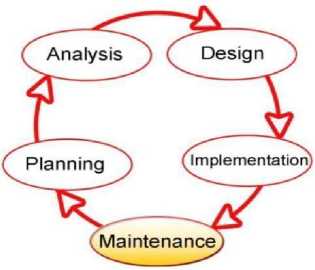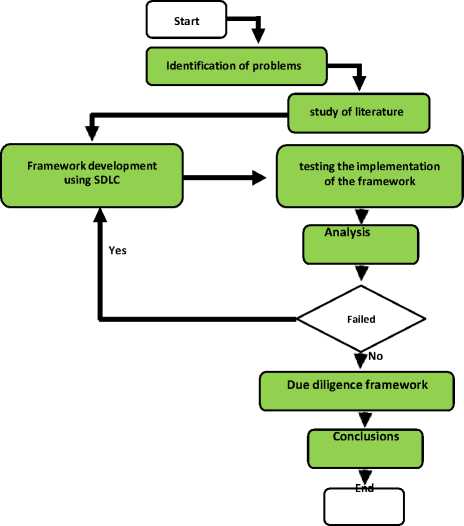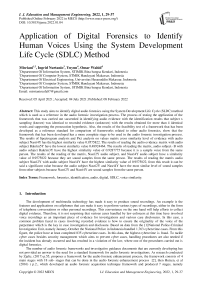Application of Digital Forensics to Identify Human Voices Using the System Development Life Cycle (SDLC) Method
Автор: Misriani, Ingrid Nurtanio, Yuyun, Omar Wahid
Журнал: International Journal of Education and Management Engineering @ijeme
Статья в выпуске: 1 vol.12, 2022 года.
Бесплатный доступ
This study aims to identify digital audio forensics using the System Development Life Cycle (SLDC) method which is used as a reference in the audio forensic investigation process. The process of testing the application of the framework that was carried out succeeded in identifying audio evidence with the identification results that subject x sampling (known) was identical to recorded evidence (unknown) with the results obtained for more than 4 identical words and supporting the prosecution hypothesis. Also, the results of the feasibility test of a framework that has been developed as a reference standard for comparison of frameworks related to other audio forensics, show that the framework that has been developed has a more complete stage to be used in the audio forensic investigation process. The results of Spectrogram analysis and Pict analysis on values matrix cross similarity level of evidence with audio subject Nasri4Y has the highest similarity value 0.9575822. The results of reading the audio evidence matrix with audio subject Bakrim5Y have the lowest similarity value 0.48924464. The results of reading the matrix, audio subject- B with audio subject Bakrim3Y have the highest similarity value of 0.9287775 because it is a sample voice from the same person. The results of the reading of the matrix, Nasri2Y audio subject, and Nasri4Y audio subject have a similarity value of 0.9575822 because they are sound samples from the same person. The results of reading the matrix audio subject Nasri2Y with audio subject Nasri4Y have the highest similarity value of 0.9575822, from this result it can be said a significant value because the audio subject Nasri2Y and Nasri4Y have the most similar level of sound samples from other subjects because Nasri2Y and Nasri4Y are sound samples from the same person.
Framework, forensics, identification, audio, digital, SDLC, voice similarity
Короткий адрес: https://sciup.org/15018276
IDR: 15018276 | DOI: 10.5815/ijeme.2022.01.04
Текст научной статьи Application of Digital Forensics to Identify Human Voices Using the System Development Life Cycle (SDLC) Method
Published Online February 2022 in MECS and Computer Science
-
1. Introduction
-
2. Related Works
The development of multimedia technology has made it easy to produce sound recordings. An example is the features and applications on cellphones that can make it easy to perform various types of recordings, either in the form of telephone conversations or other personal recordings. This convenience on the one hand will help efforts to collect digital evidence. Therefore, it is not surprising that various cases handled by law enforcers at this time have involved voice recordings as an important piece of evidence for investigations and various case disclosures. In this case, a common problem faced in cases involving recorded evidence is how to ensure the originality of the voice of the perpetrator which is the key in case investigation and disclosure. Based on data from the [1]National Police-Criminal Investigation Unit, namely January-October the National Police in Indonesia handled 1,763 cybercrime cases. From this figure, the police have at least completed 835 cybercrime cases. In this data, the highest cybercrime is fraud. To tackle cyber cases besides security management which aims to prevent cyber cases, handling procedures are also needed if the incident has already occurred and has resulted in a violation of the law, where one of the procedures carried out is digital forensics.
The number of audio forensic frameworks and investigative guidance documents that are currently developing has not provided an answer to the need for a standard framework for audio forensic investigations. As research conducted by Zjalic, (2017) p.55, proposes a framework for the audio forensic enhancement process, the framework consists of 4 main stages with 18 sub- stages that can be done in the audio forensic enhancement process [2], then Huizen, et al (2016) ) p.2., which developed an audio forensic acquisition technique framework and produced 7 stages, namely
Based on the SDLC explanation, there is a problem in this research, how is the application of Digital Forensics for Digital Audio identification using the Systems Development Life Cycle (SDLC) method, with the aim that the application of Digital Forensics for Digital Audio identification uses the Systems Development Life Cycle (SDLC) method. Audio identification for audio forensic investigations, with the human voice identification framework that will be developed, this framework can make it easy for investigators to carry out investigations related to audio evidence, as a reference for further research related to the same research studies related to development. human voice identification framework and audio forensic investigation techniques.
Several studies have been conducted previously became a reference in this research, including the Application of a System Development Life Cycle (SDLC) in Developing an Audio Forensic Framework, [9]. In this study, the analysis technique used is pictorial statistical analysis, formant analysis, and spectrogram analysis on three audio recording analyzes without manipulation of audio objects.
-
[10], Malukan research related to the evidentiary process efforts to support audio originality or the similarity of audio sources of evidence with suspects by using the pitch concept approach, statistical formant and bandwidth analysis, graphical distribution, and spectrograms.
In another study conducted by [11], this method has characteristics that can record the history of input, so it can be assumed that the method can see the previous digital forensic investigation framework (DFIF) sequence to form a new DFIF. Where this is meant is combining 6 types of frameworks and eliminating the same stages into one new framework with the sequential logic method.
-
[12], basic empathy steps in contacting Audio forensics. The goal is to combine four types of frameworks with the sequential Logic method.
-
3. Material and Method
Systems Development Life Cycle (SDLC) or the system development life cycle is basically a model and methodology that can be used to develop an existing system. According to [13] Systems Development Life Cycle (SDLC) has 5 stages such as planning, analysis, design, implementation, and maintenance (Rhodes, 2012) page 1.
In several studies above, no one has conducted an analysis related to audio recordings with different types of sound with different objects. So that this research is expected to be able to become a guide in the analysis of audio recordings, especially different audio recordings between objects.

Fig.1. SDLC stages
Source: The Systems Development Life Cycle (SDLC) as a Standard: Beyond the Documentation (2012).
-
1) Planning or the planning stage aims to identify and prioritize the system being developed, and what it wants to achieve. Planning is also the initial stage of the process of developing a framework. Where aims to extract the stages in the framework and audio forensic investigation techniques and the targets to be achieved.
-
2) The analysis is the research phase of an existing system to design a new system or update an existing system. At this stage, literature study activities are carried out to determine a case that can be handled by the system, as well as to identify the previous system for system development. The analysis process is carried out on the evidence found which will later be used in identifying the crimes that occurred and then submitted to support the trial process.
-
3) The design or system design stage is the stage for determining the process stages or techniques for implementing a new system or a system developed from the previous system. The design process also requires an analysis of the function of each stage or the technique is built. Where this stage is the process of eliminating the same stages in the framework and the audio forensic investigation technique which is used as a reference for developing the framework.
-
4) Implementation or the implementation stage is the stage for implementing a design that is built to be developed and conducting trials on the system. At this stage, the framework development process will be carried out based on the stages of the framework and previous audio forensic investigation techniques. The framework development process will be made in the form of a state chart diagram using the Microsoft Visio program. The form of the framework development will be made sequentially based on the initial stages and sub-stages from the beginning to the final stage to form a complete framework so that it can be used for audio forensic investigations.
-
5) The maintenance stage is the process of maintaining the system during use to remain able to operate properly. In the process of developing a digital audio identification framework in this study using the Systems Development Life Cycle (SDLC) method, this method is used because at the time of framework development there will be several stages that will be added and eliminated or removed without maintaining the meaning or initial arrangement of the existing framework. This framework is expected to be able to meet the standards for forensic investigation and handling of audio evidence/sound recordings.
The Application of Digital Forensics identifies the human voice using SDLC.
Figure 2 explains that this research methodology was used based on a review of previous related studies. This research method aims to develop research that has existed before. In this research, can be used the application of Digital Forensics for Digital Audio identification using the Systems Development Life Cycle (SDLC) method. This research method includes 6 main stages, namely problem identification, literature study, development framework using SDLC, framework trial and framework feasibility test, and make conclusions with regard to the results of forensic audio framework development.
The explanations related to this research method are as follows:
-
1. Problem Identification
-
2. Literature Study
-
3. Framework Development Using SDLC
That was the initial stage in research, this was done to obtain and found research topics that will be studied further to identify the problems needed for the application of digital forensics in identifying digital audio using the SDLC method.

Fig.2. Research Methodology
Список литературы Application of Digital Forensics to Identify Human Voices Using the System Development Life Cycle (SDLC) Method
- D. T. S. B. Polri., "Cyber crime cases," (2017).
- J. Zjalic, ""a Proposed Framework for Forensic Audio Enhancement," The University of Colorado." (2017).
- R. R. J. N. K. D. A. &. H. D. P. Huizen, "Voice Recording Acquisition Model In Forensic Audio.," Semnasteknomedia Online, 4 (1).," (2016)...
- M. Al-Azhar Noah, "AUDIO FORENSIC: Theory and Analysis."," (2011).
- D. E. R. Adel Alshamrani and Abdullah Bahattab in Mr. Madhup Kumar, "A Comparison between Three SDLC Models Waterfall Model, Spiral Model, and Incremental/Iterative Model," ijeme, 2018.
- Ruqia Bibi, Munazza Jannisar, Mamoona Inayet,"Quality Implication for Prognoses Success in Web Applications", International Journal of Modern Education and Computer Science(IJMECS), Vol.8, No.3, pp.37-44, 2016.DOI: 10.5815/ijmecs.2016.03.05
- Tahmoor Shoukat, Muhammad Nadeem Majeed,"Impact of Collaborative ALM on Software Project Management", International Journal of Information Technology and Computer Science(IJITCS), vol.6, no.6, pp.61-67, 2014. DOI: 10.5815/ijitcs.2014.06.09
- Héctor F. Cadavid, "Continuous Delivery Pipelines for Teaching Agile and Developing Software Engineering Skills", International Journal of Modern Education and Computer Science(IJMECS), Vol.10, No.5, pp. 17-26, 2018.DOI: 10.5815/ijmecs.2018.05.03.
- S. B. Y. P. Inggi Rahmat, "Penerapan System Development Life Sycle (SDLC) Dalam Mengembangkan Framework Audio Forensik," Vols. vol. 4, 2018..
- G. &. P. Y. Wicaksono, "Audio Forensic Techniques For Sound Analysis On Digital Evidence," Semnas Unjani, (June)," (2013).
- Y. D. &. P. Y. Rahayu, "Building an Integrated Digital Forensics Investigation Frameworks (IDFIF) Using the Sequential Logic Method," National Seminar of SENTIKA, 2014 (Sentika)." (2014).
- L. Nora, "Langkah-langkah Investigasi Audio Forensik," 2017.
- Rhodes, "Tahapan Systems Development Life Cycle," 2012.
- M. A.-A. Noah, "Audio Forensic: Theory and Analysis," p. p200, 2011.
- L. W. Q. W. A. P. I. L. Moreno, "Generalized End-To-End Loss For Speaker Verification," Cornell University, vol. v4, no. eess, 2019.


